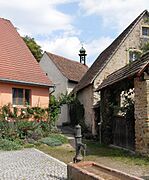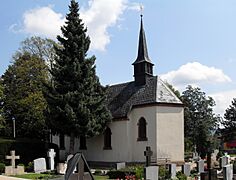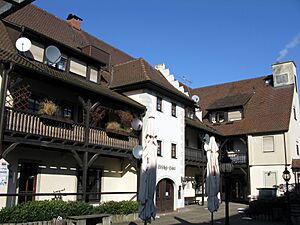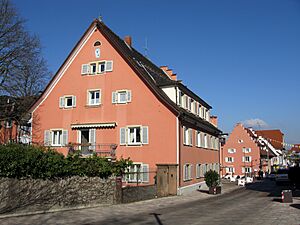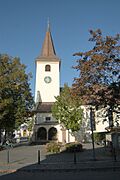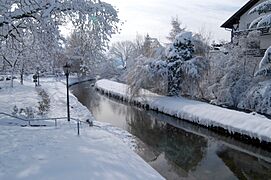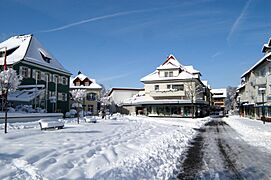Bad Krozingen facts for kids
Quick facts for kids
Bad Krozingen
|
||
|---|---|---|
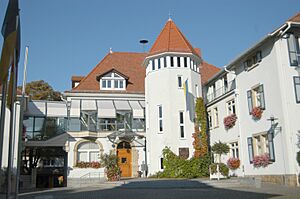
Town hall
|
||
|
||
| Country | Germany | |
| State | Baden-Württemberg | |
| Admin. region | Freiburg | |
| District | Breisgau-Hochschwarzwald | |
| Elevation | 250 m (820 ft) | |
| Population
(2022-12-31)
|
||
| • Total | 21,684 | |
| Time zone | CET/CEST (UTC+1/+2) | |
| Postal codes |
79189
|
|
| Dialling codes | 07633 | |
| Vehicle registration | FR | |
| Website | www.bad-krozingen.de | |
Bad Krozingen is a special spa town in Germany. It's located in the Baden-Württemberg region, about 15 kilometers (9 miles) southwest of the city of Freiburg. A spa town is a place known for its healing waters, which people visit for health and relaxation. In the 1970s, several smaller villages like Biengen, Hausen an der Möhlin, Schlatt, and Tunsel became part of Bad Krozingen, making it bigger.
Contents
What is Bad Krozingen Like?
Where is Bad Krozingen Located?
Bad Krozingen is in a beautiful area called Breisgau. It's about 15 kilometers southwest of Freiburg and 45 kilometers (28 miles) north of Basel, a city in Switzerland. The town is surrounded by fields of corn and tobacco. A river called the Neumagen flows through the town. It later joins another river, the Möhlin, which then flows into the big Rhine river.
What Towns are Nearby?
Bad Krozingen has several towns close by. These include Breisach am Rhine to the north, and Staufen im Breisgau and Heitersheim to the south.
Some villages that used to be separate are now part of Bad Krozingen. These include Biengen, Hausen an der Möhlin, Schlatt, and Tunsel. Each of these areas still has its own local council and mayor.
- Biengen was first mentioned in old papers way back in the year 770! It joined Bad Krozingen in 1971.
- Hausen an der Möhlin was first written about in 1147 and became part of Bad Krozingen in 1973.
- Schlatt was first mentioned in 1130. It joined Bad Krozingen in 1973.
- Tunsel was first mentioned in 852. It became part of Bad Krozingen in 1974.
A Look at Bad Krozingen's Past
Early History
People have lived in the Bad Krozingen area for a very long time! We know this because old tools and pots from the Neolithic (New Stone Age) have been found there. Later, the Celts and then the Merovingians lived here.
Around the middle of the 1st century A.D., the Romans took over this part of Germany. They built roads and homes. You can still find remains of Roman buildings and pottery today. After the Romans, the Alemanni people lived here from the 4th century. Old graves show that they had a settlement here between 500 and 700 A.D.
How Bad Krozingen Got Its Name
The town of Krozingen was first mentioned in official papers in the year 808 A.D. It was called "Scrozzinga" back then. It was probably named after a powerful Alemannic nobleman named Crozzo. The town grew from older settlements like Oberkrozingen and Kems.
For a long time, Krozingen was part of a region called Further Austria. It had different rulers, like the Schnewlin von Landeck family. The old Pfirt castle, which is now a bank building, was named after one of these ruling families.
The Discovery of Thermal Water
Something amazing happened in 1911! People were drilling for oil, hoping to find it in the Upper Rhine Plain. Instead, they found warm, healing thermal water! This was a huge discovery for Krozingen. It meant the town could become a spa town.
In 1933, after more drilling and setting up health spas, Krozingen was officially given the title "Bad." "Bad" means "bath" in German and is added to the names of spa towns. A modern spa building was finished in 1959.
Becoming a City
As the town grew, it became more important. On September 1, 2005, Bad Krozingen officially became a city! It had about 16,000 people living there, making it the second-largest town in its district.
Fun Things to See and Do
Churches and Chapels
Bad Krozingen has many interesting old churches and chapels:
- The Catholic Church St. Alban was first mentioned in 1144. In 2002, a fire damaged parts of it, but it was beautifully restored two years later.
- The Christuskirche is the first Protestant church in Bad Krozingen, built in 1935. It has amazing modern stained-glass windows made by artist Georg Meistermann between 1980 and 1981. They show different ways God has appeared in the world.
- The Glöcklehof Chapel is very old, built between the 10th and 11th centuries. It has frescoes (wall paintings) with one of the oldest pictures of Jesus found north of the Alps!
- There's a beautiful Renaissance castle called the Castle of the Barons of Gliechenstein. It was built in 1579. It has a lovely chapel that was rebuilt in the Rococo style in the 18th century. However, this chapel is not open to the public.
- St. Fridolin's Chapel is a small chapel that was probably built after the Thirty Years' War. It was fully renovated in 2014, and sometimes small concerts are held there.
- The St. Joseph's Chapel is in a courtyard area. It was built by its first private owners to thank them for getting the land.
- Chapels in Bad Krozingen
Cool Museums
Museum in Litschgihaus
This museum has two parts. One part is a history museum that tells the story of the area from the Stone Age to today. It focuses on how houses were built over time, using cool models. The other part of the museum has changing exhibits. You can visit it on Sundays.
Collection of Historical Keyboard Instruments
Since 1974, the Bad Krozingen Palace has been home to a collection of about 50 old keyboard instruments. These were collected by a harpsichord player named Fritz Neumeyer. You can see the whole collection, and sometimes you can even hear these instruments played at concerts in the palace!
Museum in Biengen Town Hall
This museum opened in 2005 thanks to a lot of hard work by local volunteers. It shows what everyday life was like for people who lived in Biengen for many generations. Volunteers help visitors, organize special exhibits, and keep the museum looking great.
Media Center
A public library, also called a Media Center, opened in April 2015 near the train station. It has about 27,000 items like books, movies, and music about general knowledge, society, culture, and science. It's a great place to learn new things!
Litschgikeller / Josefshaus
The Litschgikeller is a place where many fun cultural events happen. You can see comedy shows, theater plays, circus acts, and listen to music. There's also a special concert series called "Piano & Mehr" (Piano & More), where a beautiful Bechstein piano is played with other instruments or singers.
JOKI Cinema at the Train Station
The JOKI Cinema opened in October 2002. It used to show movies in a different building, but since March 2015, all shows are in the basement of the Media Center at the train station. The cinema is run by a group of volunteers. It shows films every day except Wednesdays and has 112 seats, plus spaces for wheelchairs.
Gallery
Famous People from Bad Krozingen
- Marquard Herrgott (1694–1762): A Benedictine monk and historian.
- Fritz Raschig (1863–1928): A chemist and politician. He was looking for oil in Krozingen, but instead, they found the carbon dioxide source that led to the town becoming a spa!
- Zenta Mauriņa (1897–1978): A writer who lived in Bad Krozingen from 1966.
- Carl Ueter (1900–1985): A composer who passed away in Bad Krozingen.
- Walter Scheel (1919–2016): A politician who was the President of Germany from 1974 to 1979. He lived in Bad Krozingen later in his life.
- Oliver Baumann (born 1990): A soccer goalie who learned to play football in Bad Krozingen when he was young.
See also
 In Spanish: Bad Krozingen para niños
In Spanish: Bad Krozingen para niños





